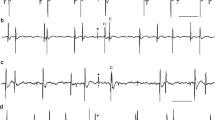Summary
In the spinal cord of anaesthetized cats, motoneurones of m.gastrocnemius medialis were stimulated to repetitive firing by very long-lasting steady currents injected through an intracellular microelectrode (maximum duration 4 min). In such discharges, a gradual decline of impulse frequency was found to occur during several tens of seconds. Most of this “late adaptation” occurred during the first 30 s of firing. Comparisons between the responses of different cells showed that the frequency-drop during late adaptation was strongly correlated to the impulse rate at the beginning of the discharge. For one and the same cell, late adaptation was more prominent at strong than at weaker intensities of stimulation (i.e., at high than at lower initial firing rates). In cells capable of discharging continuously for several minutes, a semi-stationary discharge rate tended to be reached after about 1 min or less.
Similar content being viewed by others
References
Baldissera F, Gustafsson B (1974) Firing behaviour of a neurone model based on the afterhyperpolarization conductance time course and algebraical summation. Adaptation and steady state firing. Acta Physiol Scand 92: 27–47
Baldissera F, Gustafsson B, Parmiggiani F (1978) Saturating summation of the afterhyperpolarization conductance in spinal motoneurones. A mechanism for “secondary range” repetitive firing. Brain Res 146: 69–82
Barrett EF, Barrett JN, Crill WE (1980) Voltage-sensitive outward currents in cat motoneurones. J Physiol (Lond) 304: 251–276
Colding-Jørgensen M (1977) Impulse dependent adaptation in Helix Pomatia neurones. Demonstration of the adaptation conductance. Acta Physiol Scand 101: 382–393
Granit R, Kernell D, Lammarre Y (1966) Algebraical summation in synaptic activation of motoneurones firing within the “primary range” to injected currents. J Physiol (Lond) 187: 379–399
Granit R, Kernell D, Shortess GK (1963a) Quantitative aspects of repetitive firing of mammalian motoneurones, caused by injected currents. J Physiol (Lond) 168: 911–931
Granit R, Kernell D, Shortess GK (1963b) The behaviour of mammalian motoneurones during long-lasting orthodromic, antidromic and transmembrane stimulation. J Physiol (Lond) 169: 743–754
Jack JJB, Noble D, Tsien RW (1975) Electric current flow in excitable cells. Oxford University Press, London
Kernell D (1965a) The adaptation and the relation between discharge frequency and current strength of cat lumbosacral motoneurones stimulated by long-lasting injected currents. Acta Physiol Scand 65: 65–73
Kernell D (1965b) The limits of firing frequency in cat lumbosacral motoneurones possessing different time course of afterhyperpolarization. Acta Physiol Scand 65: 87–100
Kernell D (1966) Input resistance, electrical excitability and size of ventral horn cells in cat spinal cord. Science 152: 1637–1640
Kernell D (1969) Synaptic conductance changes and the repetitive impulse discharge of spinal motoneurones. Brain Res 15: 291–294
Kernell D (1972) The early phase of adaptation in repetitive impulse discharges of cat spinal motoneurones. Brain Res 41: 184–186
Kernell D (1979) Rhythmic properties of motoneurones innervating muscle fibres of different speed in m.gastrocnemius medialis of the cat. Brain Res 160: 159–162
Kernell D, Monster AW (1980) “Fatigue properties” of hindlimb motoneurons of the cat. Soc Neurosci Abstr 6: 466
Kernell D, Monster AW (1982) Motoneurone properties and motor fatigue. An intracellular study of gastrocnemius motoneurones of the cat. Exp Brain Res 46: 197–204
Kernell D, Sjöholm H (1973) Repetitive impulse firing: comparisons between neurone models based on “voltage clamp equations” and spinal motoneurones. Acta Physiol Scand 87: 40–56
Partridge LD, Stevens CF (1976) A mechanism for spike frequency adaptation. J Physiol (Lond) 256: 315–332
Schwindt PC (1973) Membrane-potential trajectories underlying motoneuron rhythmic firing at high rates. J Neurophysiol 36: 434–449
Sokolove PG, Cooke IM (1971) Inhibition of impulse activity in a sensory neuron by an electrogenic pump. J Gen Physiol 57: 125–163
Author information
Authors and Affiliations
Additional information
Supported by NIHNS 11574 during this work
Rights and permissions
About this article
Cite this article
Kernell, D., Monster, A.W. Time course and properties of late adaptation in spinal motoneurones of the cat. Exp Brain Res 46, 191–196 (1982). https://doi.org/10.1007/BF00237176
Received:
Published:
Issue Date:
DOI: https://doi.org/10.1007/BF00237176




